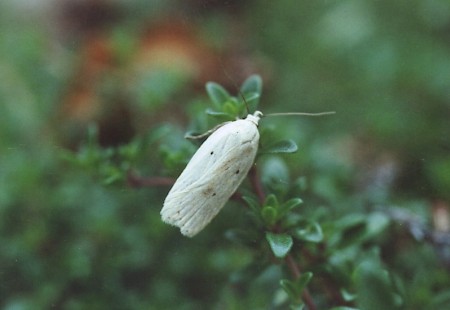32.026 BF698
Agonopterix kaekeritziana
(Linnaeus, 1767)
Wingspan 19-23 mm.
A fairly uniformly-coloured species, with two or four darker dots on the forewing. The adult can be distinguished from A. pallorella and A. bipunctosa by the rusty orange marks on its wings, though these may be minimal on worn specimens. Also, it lacks the pitchy black edge at the base of the costa found on A. pallorella.
Well distributed over most of the British Isles, and fairly common throughout, it is rare at light so is probably under-recorded. The adults are on the wing from July to September. It is most easily obtained by rearing the larvae on knapweeds (Centaurea), or netting it while nectaring at flowers after dark.
The larvae feed in spun or rolled leaves of knapweed (Centaurea spp.). Larvae can be confused with the polyphage Celypha lacunana and with A. bipunctosa (see detail below).
- Larva: (description Ian F. Smith):
Foodplants: May to June in a spun shoot, then a rolled leaf, of Centaurea nigra or Centaurea scabiosa.
Length: 14 mm described.
Head: Black with indistinct dark brown subdorsal patch. (MBGBI 4-1; black or very dark brown marbled with black)
Prothorax (T1): Anterior edge brown ochre. Prothoracic shield black.
Thoracic legs: Black.
Body: Very dark brown.
Spiracles: Peritreme pitchy.
Pinacula: Black.
Setae: Black
Anal plate: Shiny black, full width of anal segment. Posterior edge smooth with no lobe.
Prolegs: Base encircled by pitchy black band. Planta creamy white. Crochets blackish.
Similar species: The highlighted features above distinguish it from the polyphage Celypha lacunana. The larva of Agonopterix bipunctosa is indistinguishable from A. kaekeritziana, but it occurs onSerratula tinctoria.

 UKMoths
UKMoths 



